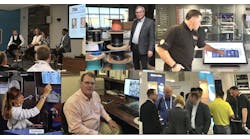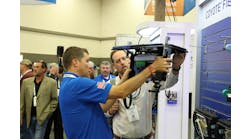Latest from Professional Development/Leadership
Executive Insights Q&A With Genia Wilbourn, Senior Vice President – Verizon Global Network Ops & Assurance
Genia Wilbourn is Senior Vice President of Verizon’s Global Network Operations & Assurance, leading network field operations for the nation’s largest and most reliable 5G and 4G LTE wireless network. This network, along with the state-of-the-art wireline OneFiber and Intelligent Edge Networks deliver the broadband connectivity that consumer and business customers rely on domestically and globally. Additionally, she leads business service delivery & assurance across more than 2,600 cities in 145 countries.
Topic: OneFiber
ISE: Share how the OneFiber and Intelligent Edge Networks initiatives impact your teams. How will the success of these programs be measured?
Wilbourn: All dense cellular networks, and 5G is no exception, require deep fiber connectivity. Verizon has undertaken a massive, multi-year redesign of our network architecture that consolidates, simplifies and modernizes our Core and Access networks. We are unifying connectivity between these networks via fiber to create one single multi-purpose architecture. We have invested billions of dollars acquiring fiber assets and building out our multi-purpose fiber footprint. This state-of-the art fiber network with advanced electronics will enable the backhaul needed to realize the data capabilities of 5G.
And, when paired with 4G and 5G node design, tremendous engineering synergy can be unlocked for rapid deployment.
Topic: OVERLOOKED ISSUES
ISE: What should all of us in the Information and Communication Technology (ICT) industry be talking about that we are not? Or, what current topic is the most important that needs additional and different attention?
Wilbourn: There is still a dramatic disparity when it comes to female representation in tech. In 2018, women held 60% of the country’s personal wealth and comprise roughly half of the workforce, yet represent only 25% of technical professions.
Technical jobs are part of the industries that are shaping the future, and we need to ensure women have a seat at the table making decisions. The way we do that is by engaging girls as early as middle school and helping them connect the dots between things they might already love (like art, music, or video games) and the technology careers that exist that enable those things.
Topic: COST-REDUCTION STRATEGIES
ISE: Many telecom providers are focusing on cost reductions, driving savings through software-based technologies, automation, supply chain, and optimizing networks. What are some successful strategies you’ve executed in these areas? What are we NOT doing that we should be doing in these areas?
Wilbourn: Virtualization continues to be a priority for us, both in terms of cost reduction, but more importantly as a critical technological innovation that holds tremendous value for our customers.
By decoupling our hardware and software, we are able to move away from purpose-built hardware — instead using common off the shelf hardware (COTS) — thereby lowering equipment costs, barriers to entry for other ecosystem players, and reducing maintenance costs.
InvisiLight® Solution for Deploying Fiber
April 2, 2022Go to Market Faster. Speed up Network Deployment
April 2, 2022Episode 10: Fiber Optic Closure Specs Explained…
April 1, 2022Food for Thought from Our 2022 ICT Visionaries
April 1, 2022Topic: 5G REALITIES
ISE: What is the most difficult thing about 5G preparedness and deploying 5G across the Network for the Global Network Operations & Assurance team?
Wilbourn: As traffic growth on the network has increased, and the need for advanced services has emerged, a small cell architecture, especially in the dense urban environment, has become critical and provides tremendous value.
Building small cells in the urban landscape is vital to meeting the needs of both 4G and 5G. As we move forward, the relationships we have with municipalities is going to be critical. Because 5G requires such dense small cell coverage and vast fiber infrastructure, working with city leaders to reach mutually beneficial attachment rates and streamline zoning and licensing is critical. We have some great success stories here.
In Boston, we recently announced an additional investment of $300 million through a public private partnership that allowed for reasonable small cell attachment rates, expanded fiber deployments, and licensing processes, as well as some smart city solutions for the city of Boston. Similarly, in San Diego, we reached a public private partnership that paved the way for $180 million investment in fiber deployments and small cells.
Thanks to these partnerships, residents and visitors in these cities will be among the first in the world to take advantage of 5G technology, and the cities will be well-positioned to deploy smart city solutions to help with traffic, parking, and other needs. Working with forward-thinking, progressive cities like Boston and San Diego is critical in advancing our 5G work.
Topic: SMART CITIES
ISE: Talk about smart cities. How can companies like Verizon encourage smart city initiatives in Tier 2 and Tier 3 cities? Share your greatest learnings about smart cities and telecom providers’ interconnected relationship. How do those relationships need to change in the future?
Wilbourn: Our goal is to provide the technology that will improve the quality of life for people living in cities around the world, and increase the ways and efficiency with which cities operate. It’s not just about smart technology, connectivity, or applications; it starts with a focus on the people and their basic wants and needs. We partner with each city to design infrastructure, systems, and processes, that elevate the way they provide services in new and cost-effective ways. We seek to be good corporate partners.
Topic: THE FUTURE
ISE: What emerging or disruptive technology excites you the most for the future of the ICT industry?
Wilbourn: 5G is a revolutionary technology which, as it matures, will have significantly advanced capabilities. We refer to those capabilities as the eight currencies of 5G, and they include being able to manage billions of devices simultaneously, being able to roll out new services in weeks as opposed to months, and delivering service with extremely low latency, extremely high reliability, massive throughput, and very fast speeds.
These capabilities will inspire development of new solutions and devices we can’t even imagine at this time — and will lead to a wide variety of use cases that include everything from massive numbers of IoT devices that do very little networking, to smartphones with infinite opportunities to use data, to more complex solutions such as AR/VR that will require massive computing capabilities on the edge of the network.
Those solutions will each require different combinations of the capabilities we can offer. In order to "right-size" network resources for these various use cases, it will require great flexibility and adaptability in the network. Relying on the virtualization in the network and built-in AI to enable dynamic allocation of the appropriate resource, we will enable network slicing which will allow us to automate network configuration changes. This includes the ability to scale up or scale down network function capacity to provide the right service levels and network resources needed for each of the use cases.
Topic: YOUR ROLE
ISE: You’ve been in your current role for 11 months. What’s the most challenging thing about being in charge of Global Network Ops & Assurance? What is the greatest thing you’ve learned thus far in this role? How do you plan to "move the needle" in your position?
Wilbourn: Earlier this year we launched Verizon 2.0 with the goal to align our network resources, business groups, talent, and strategies, in order to best deliver the products and services that matter to our customers. As the leader of a team comprised of multiple legacy business groups with varied cultures, the challenge was driving my team to take a rigorous, honest look at the way we were doing business and develop a collaborative strategy that would preserve the best of each culture, strengthen the good, and transform or eliminate what wasn’t positively impacting our customers or our business.
Topic: STEM EFFORTS
ISE: Many very smart students will not pursue STEM education. Post-graduation, is there a way to redirect them into STEM areas? What do you recommend for those who need a nudge to evolve into STEM careers?
Wilbourn: Attracting a mix of bright, diverse and passionate individuals is key as we build the teams that are building the future. We recognized at Verizon that we needed to take a closer look at the language we were using on new job requisitions. We know that it takes more than technical knowledge to successfully run a technology business — creativity and leadership skills are just as important.
We’ve also strengthened our brand identity so that prospective team members can see past the "technical" aspect of working for a network provider and focus on the impact that technology is having on the world. 5G will pave the way for an array of unprecedented innovations that will reshape cities, businesses, and society as a whole. We hope to attract folks who will want to be a part of that change!
Topic: CHANGE
ISE: What are the biggest changes you’ve seen in the last year, and what do you recommend to folks who want to grow with a company like Verizon for 20 years? What would you say to those who think staying with 1 company for 20 years is too long?
Wilbourn: On one hand, the past 20 years seem to have flown by, but when I think about the evolution of technology and of our business over that time, it seems like a lifetime. In 20 years, we’ve progressed from delivering basic analog voice and data service to our customers to now operating the industry-leading 5G network, which will enable the Fourth Industrial Revolution.
Flexibility has been key in keeping pace with these changes, which have been driven by customer needs and our passion for continuous innovation and improvement. For those who are concerned about stagnating: not a concern in the technology field! My Verizon journey has been a continuous wild and exciting ride, and I’m lucky enough to still have a seat on the leading edge!
Topic: PROBLEM-SOLVING
ISE: Share how those people on the ground can find their voices and feel heard. What can their managers do to listen better to them?
Wilbourn: We do have a formal employee idea engine at Verizon, but open dialogue with senior leaders, managers, and supervisors is key. Our most valuable resources for innovation are the team members who are building the network and serving our customers each and every day. They know best what is in their way of delivering the best customer experience, or how best to operate the most efficient, reliable and secure network. It’s our responsibility as leaders to ensure that we are cultivating an environment where team members not only feel empowered to share their ideas and feedback but feel heard when they see their ideas put into action.
Topic: INCLUSION
ISE: Share the changes you’ve sponsored or championed. What are you most proud of related to diversity and inclusion?
Wilbourn: Verizon’s global customer base is widely diverse, and we are committed to ensuring that the team that serves our customers is as well. It’s not only the right thing to do — it’s good business.
I believe that truly successful and innovative teams are made up of individuals from a variety of cultures, backgrounds, and experiences, that come together to challenge the status quo and drive real change — and I’m passionate about enabling that. I am proud to serve as the executive sponsor of the Black Resource Association of Verizon Employees (BRAVE), a Verizon employee resource group. In addition to mentoring emerging women (and men) leaders both within Verizon and externally, I also support Verizon Foundation’s Innovative Learning programs such as Black Girls Code and #weneedmore.
This year I’m excited to be the Verizon Global Network & Technology executive sponsor for our recently-launched Women of the World (WOW) initiative. This program is designed to nurture and develop the next generation of leaders here at Verizon, and brings together talented and motivated women from across the organization. 1,800 participants will progress through a 7-month journey focused on sharpening skills in the areas of self-leadership, effective communication, critical thinking, career ownership, and personal brand development.
Topic: CHANGE
ISE: How do you embrace change and encourage risk-taking across your team?
Wilbourn: Kyle Malady, Verizon’s EVP & Chief Technology Officer, is a strong proponent of curiosity, strategic risk-taking, and teamwork. He empowers and expects Verizon’s network team to tackle challenges in fresh, new ways without fear of failure. That kind of freedom is energizing and supports true innovation and collaboration. This approach eliminates bureaucracy and ensures yesterday’s processes and policies do not impede us from delivering on our 5G promise of unlimited capabilities and benefits to citizens and businesses now and in the future.
Like this Article?
Subscribe to ISE magazine and start receiving your FREE monthly copy today!
Genia Wilbourn is Senior Vice President of Verizon’s Global Network Operations & Assurance. Most recently, Ms. Wilbourn led Verizon Partner Solutions Operations, responsible for Verizon’s global wireline wholesale operations including access service ordering for core, Fiber-to-the-Cell (FTTC) and Ethernet services; competitive local exchange carrier (CLEC) ordering, installation & maintenance; voice product marketing & operations; core services regulatory support; wholesale systems transformation and wholesale business process management.
She previously led Global Engineering Design & Transport where she was responsible for engineering design, network provisioning and capacity management across Verizon’s wireline footprint. Ms. Wilbourn began her Verizon career in 1998 as a wholesale operations team leader and has since held a variety of staff and line positions of increasing responsibility in center and field operations, service delivery & assurance, and customer care.
Ms. Wilbourn holds a Bachelors of Science degree in Civil Engineering from Morgan State University. She is a graduate of the Master Series of Distinguished Leaders and was named one of OSP Magazine’s Game Changers in 2015.
She is currently executive sponsor of the Black Resource Association of Verizon Employees (BRAVE) and actively supports Verizon Foundation’s Innovative Learning mentoring programs such as Black Girls Code and #weneedmore, which seek to foster and inspire youth towards STEM (Science, Technology, Engineering & Math) careers.

Sharon Vollman | Content Ambassador for ISE EXPO
Sharon Vollman is the Content Ambassador for ISE EXPO. She is passionate about collaborating with thought leaders, SMEs and hard-working doers who design, plan and deploy ultra-reliable broadband networks. Vollman is committed to creating a variety of educational offerings for ISE EXPO attendees that inspire them to connect every U.S. citizen with the broadband networks we all want for our children and grandchildren.
Vollman has created educational partnerships with Broadband Service Providers including AT&T, Verizon, Lumen, Frontier Communications and others. She has covered the telecom industry since 1996.








